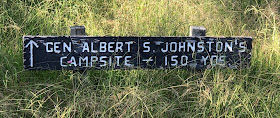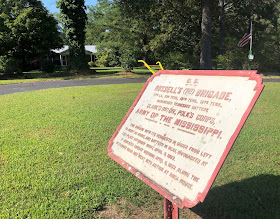 |
| Your dazed blogger at Shiloh following an awful bug attack. |
At the spring of 1862 Siege of Corinth (Miss.), his only field command of the war, Henry Halleck wasn't known for bold initiatives or lightning strikes. Plodding and overcautious, the 47-year-old Union commander took more than a month to conquer the strategic northern Mississippi town that eventually was abandoned by a vastly outnumbered enemy.
 |
| Mr. Bold, Henry Halleck, also known as "Old Brains. (Library of Congress) |
"We have let them slip through our fingers," a Union soldier wrote about the Confederates' escape.
Bleh. Let's not be like "Old Brains."
On our Civil War journeys, let's emulate J.E.B. Stuart: Be bold, deliver a few great results, occasionally ride aimlessly through the countryside, and when appropriate, party like it's September 1862. (But when riding a bicycle, do not stick a plume feather in your helmet.)
Summoning my inner Stuart, I drove from Shiloh, Tenn., to Corinth, Miss., and back on Monday, following the serpentine road “Old Brains” himself may have taken. (And then I returned to Nashville. It's not called "Labor Day" for nothing.) It was stunning I made the roughly 40-mile Shiloh-to-Corinth round trip at all because a massive insect violently struck my helmet earlier, nearly knocking me from my road bike at Shiloh.
But I was uber-determined to visit the “Crossroads of the Confederacy," where Halleck set up shop after Pierre Gustave Toutant Beauregard abandoned it for good on May 30, 1862. Join me for the ride.
En route to Corinth, near the Shiloh battlefield, I found this. Damn, I'm a sucker for every historical marker -- especially ones nearly obscured by weeds ...
... And unsurprisingly, I also discovered a Civil War Trails marker near the site of Albert Sidney Johnston's last bivouac. (They. Are. Everywhere.) The next day, April 6, 1862, ASJ was mortally wounded at Shiloh. Shot behind the right knee, the 59-year-old commander bled to death in a ravine -- even though he had a tourniquet in his pocket. (Quick plug: Read my Civil War Times column about Shiloh battlefield markers -- including the one at Johnston's death site.) ...
Keeping an eye out for angry dogs, I slowly walked down the lane to the bivouac site. Hey, did Johnston's staff forget something? ...
Arrival!
 |
| Albert Sidney Johnston |
"In 1862, James Wood (1831-1923) lived on the site of his Cotton Gin which was just north of the present restaurant at the intersection of Highway 22 and 142. Having learned that a battle was coming, he gathered his family and a few possessions, and late in the afternoon of April 5, 1862, headed southwest along the Corinth-Pittsburg Landing Road. This old road is still partially visible in the woods just north of this site.
"At this location, now marked, he found General Albert Sidney Johnston camped under a large Post Oak tree."
Over the years, Woods' relatives frequently pointed out the site to visitors. ...
... and sprinkled along Route 22, near the national military park, you'll find these fabulous, old cast-iron Shiloh historical tablets. The veterans themselves determined where most of these were placed. This one happens to be smack-dab in someone's front yard. ...
... and this one, which desperately needs TLC, denotes the position of a brigade of Johnston's Army of the Mississippi. Off to our main destination ...
"Corinth, Mississippi, to be Waterloo of the war," the New York Herald predicted in early April 1862," before the result of the Battle of Shiloh.
Well, Beauregard's boys held out much longer than expected -- thanks to Halleck's case of the slows and some ingenious subterfuge that included Quaker guns in earthworks.
A few miles north of downtown Corinth, the National Park Service maintains a small site where you can view Confederate earthworks in the woods. Trust me. They are out there. Somewhere. ...
... and deep in those same woods, I also found this. Hmmm... not encouraging.
Finally, the Crossroads of the Confederacy!
On my last visit to Corinth, I ignored this famous junction, visiting instead an indoor Civil War axe throwing venue on North Fillmore. ("Whether you want to channel your inner lumber jack or just try out a fun and competitive hobby," according to this tout, "axe throwing is a fun and unique sport that’s taking North America by storm.") Hmmm ... that wouldn't cut it for me this time.
Corinth was at the junction of two vital railroad lines, the Mobile & Ohio and Memphis & Charleston, hence the U.S. Army’s huge interest in occupation. Strange as it may seem, this humble town helped keep the Confederate Army fueled for fighting in the Western theater and beyond. "More important than Richmond," some big-wigs in the Federal command called Corinth.
There's a museum at the depot, but it was closed because of the holiday. Bummer.
... but there's still plenty to see near the railroad junction. Here's the site on Fillmore Street of long-gone Rose Cottage, where Johnston made his HQ and after Shiloh his body lay in state.
... and here's the beautiful, privately owned house down the street that Confederate general Leonidas Polk used as headquarters.
... and on Polk Street Street stands the old W.L. Duncan House, used by Beauregard as a headquarters and later by Union General William Rosecrans during the Battle of Corinth in early October 1862. (It's now a private dwelling.) Confederate Private Thomas Duncan wrote his war-time recollections here in his boyhood home, which once stood on Jackson Street.
...and on Jackson Street, we find the outstanding Verandah-Curlee House, the exclamation point of my visit. OMG! OMG! Owned by the city and open for tours, it was used by Confederate generals John Bell Hood and Braxton Bragg as a headquarters and by "Old Brains" himself in 1862. Ah, I could feel my IQ rising as I soaked in this scene. The site of Ulysses Grant's HQ, now occupied by Corinth police headquarters, is directly across the street.
OK, we're done with ya, Corinth. Until next time ...
OK, time's up. Thanks for riding along.
Let's keep history alive.

















No comments:
Post a Comment